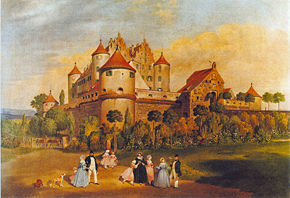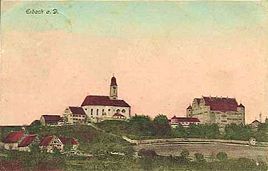
Erbach Castle
Encyclopedia


Renaissance
The Renaissance was a cultural movement that spanned roughly the 14th to the 17th century, beginning in Italy in the Late Middle Ages and later spreading to the rest of Europe. The term is also used more loosely to refer to the historical era, but since the changes of the Renaissance were not...
castle situated on a hillside close to the ciy of Erbach an der Donau
Erbach an der Donau
Erbach an der Donau is a town on the Danube River in Baden-Württemberg, Germany. Located in the Alb-Donau District, Erbach lies between Ulm and Ehingen an der Donau on the southern edge of the Swabian Alb.-History:...
in the state of Baden Württemberg, Germany
Germany
Germany , officially the Federal Republic of Germany , is a federal parliamentary republic in Europe. The country consists of 16 states while the capital and largest city is Berlin. Germany covers an area of 357,021 km2 and has a largely temperate seasonal climate...
. The current owner is Baron
Freiherr
The German titles Freiherr and Freifrau and Freiin are titles of nobility, used preceding a person's given name or, after 1919, before the surname...
zu Ulm-Erbach.
History
The origins of the castle date back to the 12th century. The task of the castle was to secure and safeguard the important crossing over the river DanubeDanube
The Danube is a river in the Central Europe and the Europe's second longest river after the Volga. It is classified as an international waterway....
. The keep was built during the reign of the House of Hohenstaufen and explicitly mentioned in a document from 1384. The Gothic
Gothic architecture
Gothic architecture is a style of architecture that flourished during the high and late medieval period. It evolved from Romanesque architecture and was succeeded by Renaissance architecture....
spire
Spire
A spire is a tapering conical or pyramidal structure on the top of a building, particularly a church tower. Etymologically, the word is derived from the Old English word spir, meaning a sprout, shoot, or stalk of grass....
was added at the end of the 15th century. The original modest Romanesque
Romanesque architecture
Romanesque architecture is an architectural style of Medieval Europe characterised by semi-circular arches. There is no consensus for the beginning date of the Romanesque architecture, with proposals ranging from the 6th to the 10th century. It developed in the 12th century into the Gothic style,...
castle was extended in the 16th century into a renaissance
Renaissance
The Renaissance was a cultural movement that spanned roughly the 14th to the 17th century, beginning in Italy in the Late Middle Ages and later spreading to the rest of Europe. The term is also used more loosely to refer to the historical era, but since the changes of the Renaissance were not...
palace. In 1525 during the German Peasants' War
German Peasants' War
The German Peasants' War or Great Peasants' Revolt was a widespread popular revolt in the German-speaking areas of Central Europe, 1524–1526. At its height in the spring and summer of 1525, the conflict involved an estimated 300,000 peasants: contemporary estimates put the dead at 100,000...
the castle was damaged by revolting farmers of the Baltringer Haufen
Baltringer Haufen
The Baltringer Haufen was prominent among several armed groups of peasants and craftsmen during the German Peasants' War of 1524-1525. The name derived from the small Upper Swabian village of Baltringen, which lies approximately south of Ulm in the district of Biberach, Germany...
.
Hans von Paumgarten, a patrician from Augsburg
Augsburg
Augsburg is a city in the south-west of Bavaria, Germany. It is a university town and home of the Regierungsbezirk Schwaben and the Bezirk Schwaben. Augsburg is an urban district and home to the institutions of the Landkreis Augsburg. It is, as of 2008, the third-largest city in Bavaria with a...
, was enfeoffed with Erbach Castle in 1534. His heir, Hans Georg von Paumgarten, started works to rebuild the castle on a large scale in 1550: two wings alongside each other on top of large vaulted basement rooms, three storeys high with four more levels under the roofs. The works were completed in 1555, ruining Hans Georg von Paumgarten.
In 1612 Hans Ludwig of Ulm became lord
Lord
Lord is a title with various meanings. It can denote a prince or a feudal superior . The title today is mostly used in connection with the peerage of the United Kingdom or its predecessor countries, although some users of the title do not themselves hold peerages, and use it 'by courtesy'...
of Erbach. During the Thirty Years' War
Thirty Years' War
The Thirty Years' War was fought primarily in what is now Germany, and at various points involved most countries in Europe. It was one of the most destructive conflicts in European history....
Bernard of Saxe-Weimar, one of the foremost Protestant
Protestantism
Protestantism is one of the three major groupings within Christianity. It is a movement that began in Germany in the early 16th century as a reaction against medieval Roman Catholic doctrines and practices, especially in regards to salvation, justification, and ecclesiology.The doctrines of the...
generals, resided at Erbach Castle in 1633. Following a prolonged period of occupation by Swedish troops, the castle was left in an uninhabitable state. After the Thirty Years' War a pleasure garden, non-existent today, was added to the castle. The last substantial alterations to the castle were carried out in the first half of the 18th century. In 1902 the castle was decorated in neo-baroque style.
Buildings
Erbach Castle was inspired by the architectural style employed by patricians of the larger cities, evidence for which are crow-stepped gableCrow-stepped gable
A Stepped gable, Crow-stepped gable, or Corbie step is a stair-step type of design at the top of the triangular gable-end of a building...
s and the gabled roofs
Gable
A gable is the generally triangular portion of a wall between the edges of a sloping roof. The shape of the gable and how it is detailed depends on the structural system being used and aesthetic concerns. Thus the type of roof enclosing the volume dictates the shape of the gable...
. Entrance to the castle is via a drawbridge
Drawbridge
A drawbridge is a type of movable bridge typically associated with the entrance of a castle surrounded by a moat. The term is often used to describe all different types of movable bridges, like bascule bridges and lift bridges.-Castle drawbridges:...
, followed by a gate. The castle courtyard is surrounded by mews
Mews
Mews is a primarily British term formerly describing a row of stables, usually with carriage houses below and living quarters above, built around a paved yard or court, or along a street, behind large city houses, such as those of London, during the 17th and 18th centuries. The word may also...
and outbuildings. In the courtyard there is a hand-drawn water well
Water well
A water well is an excavation or structure created in the ground by digging, driving, boring or drilling to access groundwater in underground aquifers. The well water is drawn by an electric submersible pump, a trash pump, a vertical turbine pump, a handpump or a mechanical pump...
. The Baroque
Baroque
The Baroque is a period and the style that used exaggerated motion and clear, easily interpreted detail to produce drama, tension, exuberance, and grandeur in sculpture, painting, literature, dance, and music...
castle chapel is situated at the end of the main hall.
The so-called Renaissance Room was altered in 1884 for the last time; other rooms worth mentioning are the Small Smoking room
Smoking room
A Smoking room is a room which is specifically provided and furnished for smoking, generally in buildings where smoking is otherwise prohibited....
, the Maria-Theresia
Maria Theresa of Austria
Maria Theresa Walburga Amalia Christina was the only female ruler of the Habsburg dominions and the last of the House of Habsburg. She was the sovereign of Austria, Hungary, Croatia, Bohemia, Mantua, Milan, Lodomeria and Galicia, the Austrian Netherlands and Parma...
-Drawing room, the Brown Drawing room, the Red Drawing room and the Clerical Drawing room.

